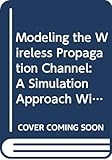Modeling the wireless propagation channel : a simulation approach with Matlab / F. P�erez-Font�an and P. Mari�no-Espi�neira.
By: P�erez-Font�an, F [author.] .
.
Contributor(s): Mari�no-Espi�neira, P | IEEE Xplore (Online Service) [distributor.]
| IEEE Xplore (Online Service) [distributor.] | Wiley [publisher.]
| Wiley [publisher.] .
.
Material type:  BookSeries: Wireless communications and mobile computing: Publisher: Chichester, West Sussex, England ; Wiley, 2008Distributor: [Piscataqay, New Jersey] : IEEE Xplore, [2008]Description: 1 PDF (xvi, 252 pages) : illustrations.Content type: text Media type: electronic Carrier type: online resourceISBN: 9780470751749.Subject(s): MATLAB
BookSeries: Wireless communications and mobile computing: Publisher: Chichester, West Sussex, England ; Wiley, 2008Distributor: [Piscataqay, New Jersey] : IEEE Xplore, [2008]Description: 1 PDF (xvi, 252 pages) : illustrations.Content type: text Media type: electronic Carrier type: online resourceISBN: 9780470751749.Subject(s): MATLABIncludes bibliographical references and index.
Contents About the Series Editors Preface Acknowledgments 1 Introduction to Wireless Propagation 1.1 Introduction 1.2 Wireless Propagation Basics 1.3 Link Budgets 1.4 Projects 1.5 Summary References Software Supplied 2 Shadowing Effects 2.1 Introduction 2.2 Projects 2.3 Summary References Software Supplied 3 Coverage and Interference 3.1 Introduction 3.2 Hata Model 3.3 Projects 3.4 Summary References Software Supplied 4 Introduction to Multipath 4.1 Introduction 4.2 Projects 4.3 Summary References Software Supplied 5 Multipath: Narrowband Channel 5.1 Introduction 5.2 Projects 5.3 Summary References Software Supplied 6 Shadowing and Multipath 6.1 Introduction 6.2 Projects 6.3 Summary References Software Supplied 7 Multipath: Wideband Channel 7.1 Introduction 7.2 Deterministic Multiple Point-Scatterer Model 7.3 Channel System Functions 7.4 Stochastic Description of the Wireless Channel 7.5 Projects 7.6 Summary References Software Supplied 8 Propagation in Microcells and Picocells 8.1 Introduction 8.2 Review of Some Propagation Basics 8.3 Microcell and Picocell Empirical Models 8.4 Projects 8.5 Summary References Software Supplied 9 The Land <st1:place w:st="on">Mobile</st1:place> Satellite Channel 9.1 Introduction 9.2 Projects 9.3 Summary References Software Supplied 10 The Directional Wireless Channel 10.1 Introduction 10.2 MIMO Systems 10.3 Projects 10.4 Summary References Software Supplied Index
Restricted to subscribers or individual electronic text purchasers.
A practical tool for propagation channel modeling with MATLAB(R) simulations. Many books on wireless propagation channel provide a highly theoretical coverage, which for some interested readers, may be difficult to follow. This book takes a very practical approach by introducing the theory in each chapter first, and then carrying out simulations showing how exactly put the theory into practice. The resulting plots are analyzed and commented for clarity, and conclusions are drawn and explained from the obtained results. Key features include: . A unique approach to propagation channel modeling with accompanying MATLAB(R) simulations to demonstrate the theory in practice . Contains step by step commentary and analysis of the obtained simulation results in order to provide a comprehensive and structured learning tool . Covers a wide range of topics including shadowing effects, coverage and interference, Multipath Narrowband channel, Multipath Wideband channel, propagation in micro and pico-cells, the land mobile satellite (LMS) channel, the directional Multipath channel and MIMO and propagation effects in fixed radio links (terrestrial and satellite) . The book comes with an accompanying website that contains the MATLAB(R) simulations and allows readers to try them out themselves . Well suited for lab-use, as reference and as a self-learning tool both for advanced students and professionals Modeling the Wireless Propagation Channel: A simulation approach with MATLAB(R) will be best suited for postgraduate (Masters and PhD) students and practicing engineers in telecommunications and electrical engineering fields, who are seeking to familiarise themselves with the topic without too many formulas. The book will also be of interest to network engineers, system engineers and researchers.
Also available in print.
Mode of access: World Wide Web
Description based on PDF viewed 10/24/2017.


There are no comments for this item.